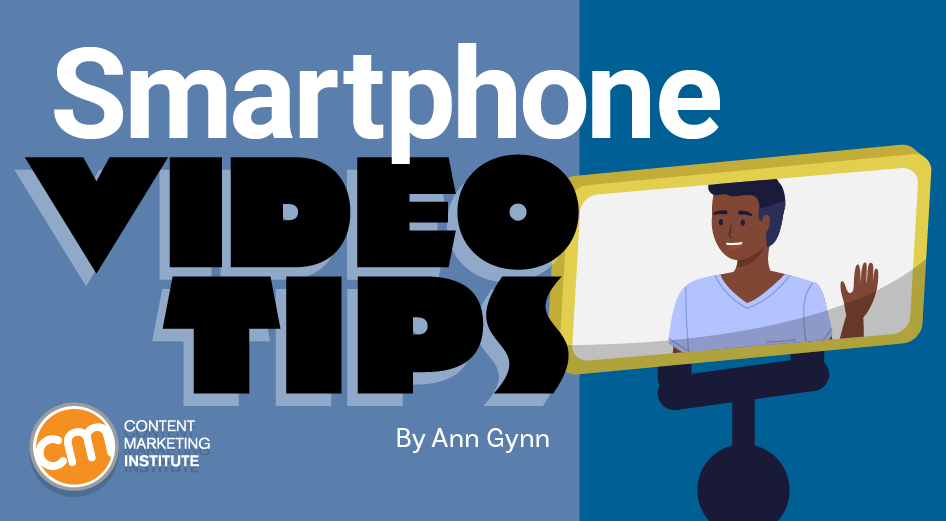MARKETING
Expert Tips for Pro-Quality Footage

More and better.
That’s what marketers say they need to improve the average and below-average results from their video content, according to CMI’s Video and Visual Storytelling Survey.
They need more budget (52%), more human resources (46%), and more training (33%). They also want better on-camera talent (27%), better equipment, production, and editing tools (25%), and better quality (21%).
More budget and better equipment aren’t necessary to create quality #video when you have a mobile phone via @SaralinaDigital @AnnGynn @CMIContent. Click To Tweet
But “more” and “better” may not be as necessary as you think if you follow the advice of Sarah Sweeney, the owner of SaralinaDigital. Watch the video below or keep reading for the highlights.
Get over your hesitation
The first hurdle to great video is just getting started.
Sarah says people often don’t know where to start. Some don’t want to be on camera. Others think they need high-quality and expensive gear. “They don’t know you can create studio-quality video from the comfort of your iPhone,” she says.
Given the billions watching videos monthly on TikTok (1 billion), Instagram Reels (2.35 billion), and YouTube (2.68 billion), that should be a good enough reason for marketers to get started, Sarah says.
Need an added incentive? Two-thirds of B2B buyers in a HubSpot survey say they’ve watched a video to learn about a brand or its products.
Focus on quality
Quality matters to viewers. The HubSpot research found 64% say it’s somewhat or very important. But that doesn’t require expensive equipment.
Modern phones let you shoot video in 4K quality. “You want quality because people equate quality to the quality of your service, quality of your product, and you want that video to last a long time,” she says.
Sarah also recommends you shoot the video at 30 frames per second, especially if the lighting is not perfect.
Shoot #video from your phone in 4K quality at 30 frames per second, says @SaralinaDigital via @AnnGynn @CMIContent. Click To Tweet
By producing high-quality videos, you also can more easily repurpose them into multiple formats, from your website to social media.
TIP: Buy a phone just to shoot videos for your business, as 4K video consumes a lot of data storage.
Get the right setup
Though you don’t need to invest in expensive equipment, you should invest in three must-have tools for shooting video from your phone – a tripod, lighting, and a microphone.
Forget the flimsy tripods as they break easily. Instead, buy a tripod with a fluid head. Sarah uses a Pivo tripod, which generally costs less than $100.
Buy a tripod with a fluid head for better-quality #video. It’s usually less than $100, says @SaralinaDigital via @AnnGynn @CMIContent. Click To Tweet
Lighting is next on her list. “When you don’t use lighting, your video will look grainy because your cell phone camera lens is working so hard to lighten it up that it will look pixelated,” Sarah explains.
CMI’s LinkedIn Live host Amanda Subler shared with Sarah and the viewers that she uses Mountdog’s softbox lighting kit ($60).
Finally, buy a good microphone. Sarah uses a Rode Mic Mini ($99) for livestreams and podcasts. It can connect through a USB cable to a computer or phone (an adapter is required for the iPhone). She uses a lavalier mic that she clips to her lapel for Instagram Live videos to make sure her audience can hear studio-quality sound.
TIP: Though not necessary, sound-absorbing panels can be a smart investment. They prevent sounds – what you’re recording and external disruptive noises – from reverberating through the office or house.
Make it comfortable for you and your viewers
Some people have a flight-or-fight response when they think about being on camera. “It’s OK. It’s normal. We’ve all been there,” Sarah says.
Picking the fight response – committing to going on camera – is a good choice because a human should be in a brand’s videos to gain viewers’ trust and demonstrate the company’s transparency.
To make the recording more comfortable for the speaker and the viewer, Sarah suggests the on-camera person should:
- Project their voice to elicit viewer confidence.
- Make eye contact with the camera to be viewed as transparent and trustworthy.
- Speak in their typical mannerisms (i.e., body language) as that genuineness brings people into the brand.
To get comfortable with that presentation style, the person should practice on camera and review the recording to identify areas to improve.
TIP: Instagram offers a mock-live setting where you can change the audience setting so no one sees you.
Script the conversation and edit the video
Though tempting, speaking extemporaneously should be avoided. A script allows the brand to ensure the video serves the marketing goal. In many cases, the video should follow a similar format – identify a problem viewers may or may not realize they have, explain the solution, and connect the problem and solution for the viewer (i.e., prospective buyer).
TIP: For short-form videos, keep the script to a minute or less (about 120 words).
When the script is followed and the recording is complete, Sarah recommends an app called InShot to edit videos on your phone. It works well as an introductory-level editing tool. “You don’t need to get fancy” by adding transitions and graphics, she says.
As you gain confidence in your skills, you can add a graphic explaining the video topic and then maybe a transition. “Before you know it, you’re going to be creating videos with transitions and brand graphics,” Sarah says.
But you can’t get there – and you certainly can’t get better-than-average results – if you don’t first appreciate more budget and people and better tools and talent aren’t required. Now, what will you shoot first?
All tools mentioned in the article are identified by the author. If you have a tool to suggest, please feel free to add it in the comments.
HANDPICKED RELATED CONTENT:
Cover image by Joseph Kalinowski/Content Marketing Institute


















